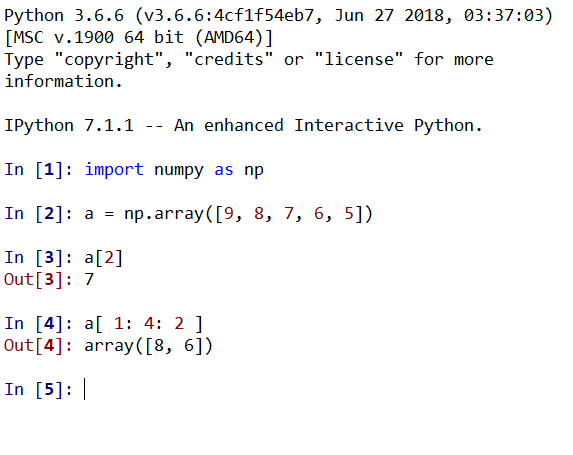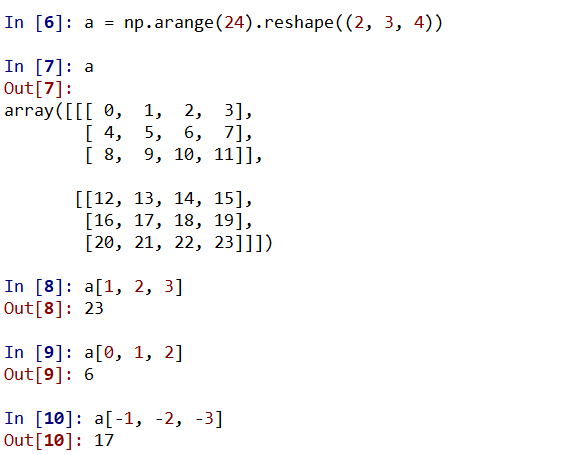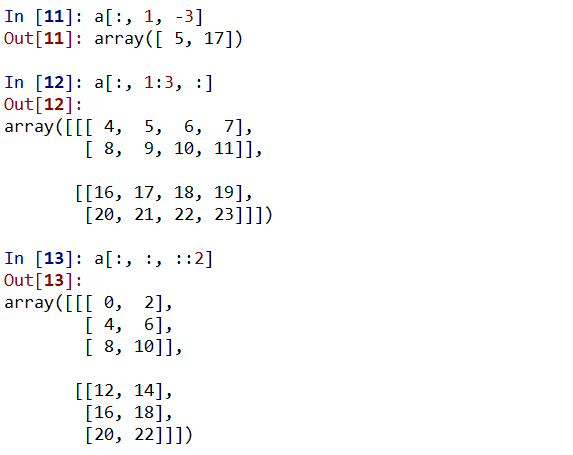Python数据分析与展示(一)Numpy库入门
环境搭建
安装numpy、scipy、matplotlib、ipython、pandas等必要包
pip install numpy scipy matplotlib ipython jupyter pandas sympy nose
安装Spyder3
pip install spyder
或者直接安装集成环境anaconda
1、Numpy数组对象:ndarray
ndarray是一个多位数组对象,有两部分组成:
- 实际的数据
- 描述数据的元数据(数据维度、数据类型)
ndarray数组一般要求所有元素类型相同(同质),数组下标从0开始
轴(axis):保存数据的维度,秩(rank):轴的数量
ndarray对象的属性
| 属性 | 说明 |
|---|---|
.ndim |
秩,即轴的数量或维度的数量 |
.shape |
ndarray对象的尺度,对于矩阵,n行m列 |
.size |
ndarray对象元素的个数,相当于.shape中n*m的值 |
.dtype |
ndarray对象的元素类型 |
.itemsize |
ndarray对象中每个元素的大小,以字节为单位 |
ndarray的元素类型
| 数据类型 | 说明 |
|---|---|
| bool | 布尔类型,True或False |
| intc | 与C语言中的int类型一致,一般是int32或int64 |
| intp | 用于索引的整数,与C语言中ssize_t一致,int32或int64 |
| int8 | 字节长度的整数,取值:[ − 128 , 127 -128, 127 −128,127] |
| int16 | 16位长度的整数,取值:[ − 32768 , 32767 -32768, 32767 −32768,32767] |
| int 32 | 32位长度的整数,取值:[ − 2 31 , 2 31 − 1 -2^{31}, 2^{31}-1 −231,231−1] |
| int64 | 64位长度的整数,取值:[ − 2 63 , 2 63 − 1 -2^{63}, 2^{63}-1 −263,263−1] |
| uint8 | 8位无符号整数,取值:[0, 255] |
| uint16 | 16位无符号整数,取值:[0, 65535] |
| uint32 | 32位无符号整数,取值:[0, 2 32 − 1 2^{32}-1 232−1] |
| uint64 | 64位无符号整数,取值:[0, 2 64 − 1 2^{64}-1 264−1] |
| float16 | 16位半精度浮点数:1位符号位,5位指数,10位尾数 |
| float32 | 32位半精度浮点数:1位符号位,8位指数,23位尾数 |
| float64 | 64位半精度浮点数:1位符号位,11位指数,52位尾数 |
| complex64 | 复数类型,实部和虚部都是32位浮点数 |
| complex128 | 复数类型,实部和虚部都是64位浮点数 |
ndarray数组可以由非同质对象构成
非同质ndarray元素为对象类型
非同质ndarray对象无法有效发挥Numpy优势,尽量避免使用
2、ndarray数组的创建和变换
ndarray数组的创建方法
从Python列表、元组等类型创建
x = np.array(list/tuple)
x = np.array(list/tuple, dtype=np.float32)
使用Numpy函数创建
| 函数 | 说明 |
|---|---|
np.arange(n) |
类似range()函数,返回ndarray类型,元素从0到n-1 |
np.ones(shape) |
根据shape生成一个全1数组,shape是元祖类型 |
np.zeros(shape) |
根据shape生成一个全0数组,shape是元祖类型 |
np.full(shape, val) |
根据shape生成一个数组,每个元素值都是val |
np.eye(n) |
创建一个正方的n*n单位矩阵,对角线为1,其余为0 |
np.ones_like(a) |
根据数组a的形状生成一个全1数组 |
np.zeros_like(a) |
根据数组a的形状生成一个全0数组 |
np.full_like(a, val) |
根据数组a的形状生成一个数组,每个元素值都是val |
np.linspace() |
根据起止数据等间距地填充数据,形成数组 |
np.concatenate() |
将两个或多个数组合并成一个新的数组 |
ndarray数组的维度变换
| 方法 | 说明 |
|---|---|
.reshape(shape) |
不改变数组元素,返回一个shape形状的数组,原数组不变 |
.resize(shape) |
与.reshape()功能一致,但修改原数组 |
swapaxes(ax1, ax2) |
将数组n个维度中两个维度进行调换 |
flatten() |
对数组进行降维,返回折叠后的一维数组,原数组不变 |
3、ndarray数组的操作:索引和切片
索引:获取数组中特定位置元素
切片:获取数组元素子集
一维数组的索引和切片:与Python的列表类似
a = np.array([9, 8, 7, 6, 5])
#索引
a[2]
#切片
a[ 1: 4: 2 ] # 起始编号:终止编号(不含):步长,三元素冒号分割
多维数组的索引
a = np.arange(24).reshape((2, 3, 4))
# 索引
a[1, 2, 3]
a[0, 1, 2]
a[-1, -2, -3]
#切片
a[:, 1, -3] # 选取一个维度用:
a[:, 1:3, :] # 每个维度切片方法与一维数组相同
a[:, :, ::2] # 每个维度可以使用步长跳跃切片
4、ndarray数组的运算
数组与标量之间的运算:作用于数组每一个元素
# 计算a与元素平均值的商
a = np.arange(24).reshape((2, 3, 4))
a = a / a.mean()
Numpy一元函数对ndarray中的数据执行元素级运算的函数
| 函数 | 说明 |
|---|---|
np.abs(x) np.fabs(x) |
计算数组各元素的绝对值 |
np.sqrt(x) |
计算数组各元素的平方根 |
np.square(x) |
计算数组各元素的平方 |
np.log(x) np.log10(x) np.log2(x) |
计算数组各元素的自然对数、10底对数和2底对数 |
np.cell(x) np.floor(x) |
计算数组各元素的celling值或floor值 |
np.rint(x) |
计算数组各元素的四舍五入值 |
np.mod(x) |
将数组各元素的小数和整数部分以两个独立数组形式返回 |
np.cos(x) np.cosh(x) np.sin(x) np.sinh(x) np.tan(x) np.tanh(x) |
计算数组各元素的普通型和双曲型三角函数 |
np.exp(x) |
计算数组各元素的指数值 |
np.sign(x) |
计算数组各元素的符号值,1(+),0,-1(-) |
Numpy二元函数
| 函数 | 说明 |
|---|---|
+ - * / ** |
两个数组各元素进行对应运算 |
np.maximum(x,y) np.fmax() np.minimum(x,y) np.fmin() |
元素级的最大值/最小值计算 |
np.mod(x,y) |
元素级的模运算 |
np.copysign(x,y) |
将数组y中各元素值的符号赋值给数组x对应元素 |
> < >= <= == != |
算数比较,产生布尔型数组 |
本文章总结于中国大学MOOC网的Python数据分析于展示课程,北京理工大学计算机学院的嵩天副教授讲授。
此总结在CSDN上分章发表,合集将会发布在我的博客上。




